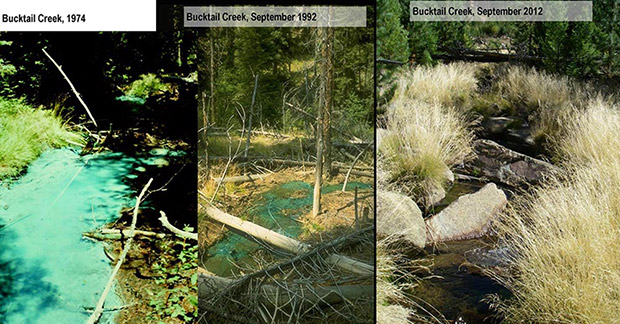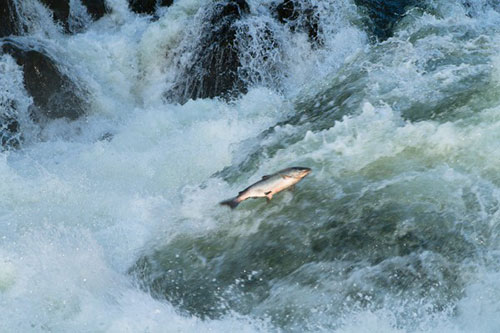
The first time Chris Mebane visited Blackbird Mine in 1992, polluted runoff from the mining site had created a toxic rainbow. Blackbird Creek was running bright red, Bucktail Creek was an eerie neon blue, and Panther Creek was nearly devoid of aquatic insects, never mind salmon. When Mebane dropped test cages full of rainbow trout into Blackbird Creek, the fish were dead within 48 hours. “It was about as lifeless as you can get outside of an autoclave,” he recalls.
Two decades later, however, Mebane and his colleagues have published a new study demonstrating a dramatic turnaround. The damaged ecosystem has nearly returned to full health — a vindication of one of the West’s largest mine cleanups.
The sordid saga of Blackbird Mine begins in the late 1800s, when mining companies first began digging tunnels and open pits to extract copper and cobalt. As production ramped up, so did the accumulation of acidic tailings — nearly 10 billion pounds altogether. The waste tainted surrounding creeks, forming a “chemical dam” in Panther Creek: a wedge of polluted water, impassable to fish.
Back in ‘92, Mebane’s grim testimony convinced the National Oceanic and Atmospheric Administration to enter the fray on behalf of salmon, adding another player to the legal muddle. Blackbird had changed hands numerous times over the years, and its owners, Noranda and Hanna, were reluctant to pay for their predecessors’ sins. Finally, in 1995, the sparring parties reached a settlement: Four companies would pay $50 million to clean up the festering site.
In the coming years, the mining firms pulled out all the stops. They relocated sediment, built containment dams and, rather creatively, routed water through the mine’s tunnels to a treatment plant. They also improved fish habitat, primarily by erecting livestock fencing along streambanks, to compensate for harm to salmon. “We were among the first in the Upper Salmon Basin to attempt riparian fencing, before most people were thinking about it,” says Noranda attorney Bruce Smith.
As the cleanup proceeded, Mebane changed jobs a few times, eventually transferring to the U.S. Geological Survey, where he works today as a self-described “dirty water biologist.” But Blackbird Mine never strayed far from his thoughts. And as he and other scientists kept tabs on the afflicted creeks, they noticed some encouraging developments: Life was returning to the lifeless streams.
The first to bounce back were the salmonids, which recolonized streams as copper and cobalt concentrations waned. By 2002, rainbow trout were again present in all of the once-poisoned creeks; now they’ve returned to full abundance. Chinook salmon began spawning in Panther Creek in the early aughts as well, a process that the state expedited — perhaps a touch rashly — by dumping in a load of hatchery fish in 2001. Today, Panther’s salmon run is self-sustaining.
To be sure, not every creek-dweller proved so instantly resilient. The diversity of aquatic insects — aka trout chow — is still down by 10 to 30 percent. Perhaps that’s because those invertebrates are more sensitive to lingering toxicants, or maybe the insects that recovered first are outcompeting the later arrivals. Regardless, the stunted bug diversity doesn’t appear to be holding back fish.
So can we say Idaho has fully recovered from the ravages of Blackbird Mine? Not exactly: Restoration is more like climbing a flight of stairs than shooting up in an elevator, and there are still steps to ascend — fish haven’t yet resettled the upper stretches of Blackbird Creek, for instance. Still, the ecosystem has climbed a long way already. “It’s taken more work and more money than anybody anticipated, but when you look at the biological outcome, everybody feels very good about the work we’ve done,” says Smith.
Mebane agrees. “This place has always been a cautionary tale: If you’re building a new mine, don’t let this happen to you,” he says. “But it’s a story of hope and redemption, too. You can put Humpty-Dumpty back together again — even if Humpty-Dumpty ends up with some scar tissue.”
Ben Goldfarb is a Seattle-based correspondent for High Country News. Correction: And earlier version of this story stated that Blackbird Mine is now owned by Rio Tinto, which is incorrect. HCN regrets this error.



